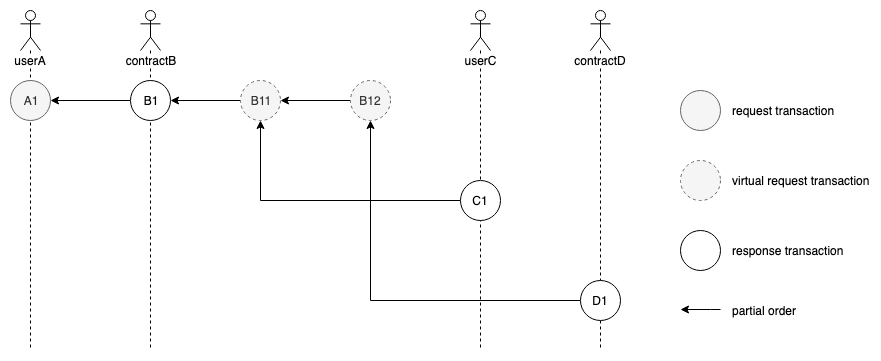# Request / Response Model
Vite's asynchronous design mainly lies in three aspects.
- Asynchronous request and response
- Asynchronous transaction writing and confirmation
- Asynchronous communication between smart contracts
Here we focus on the first aspect.
The typical model for devices communicating on a network is request-response. In the request-response model, a client requests data, and a server responds to the request by providing the data. The same concept applies to Vite and Solidity++ just with slightly different terms.
# Transactions
Transactions on Vite can be categorized as request (send) transactions and response (receive) transactions. We distinguish between the following scenarios:
- Token Transfer: User ⇋ User
- a user address sends funds to another user address
- Contract invocation: User ⇋ Contract or Contract ⇋ Contract
- a user address invokes a function of a contract address
- a contract address invokes the function of another contract address
Regardless of the scenario, two successive transactions get generated on the ledger. Each transaction only affects the state of a single address and transactions do not interfere with one another, which improves throughput.
In most cases, a transaction refers to an account block on Vite.
# RS (Receive-Send) Blocks
A request transaction to a smart contract may change the status of multiple user accounts or contracts. Imagine a Tipbot contract which sends "small tips" to many addresses in one transaction. By design, many new request transactions should be created and sent out after the contract response is complete. However, as a result, this breaks ACID principles that a transaction must hold. To prevent this, VEP-7 (opens new window) has been introduced to merge the in-contract request transactions into the original response as one whole transaction. The merged block contains a response transaction and multiple request transactions. We call such merged blocks as RS blocks.
As shown in the figure below, one request block A1 and three response blocks B1, C1 and D1 are created, and the in-contract request block B11 and B12 are merged into B1, which is a RS block in fact.

RS block has the following benefits:
- ACID is guaranteed since the response transaction and in-contract request transactions are written into one block
- Duplicated data are removed since blocks are merged
- Request-response relationship is preserved since each in-contract request has independent transaction hash
# A Simple Solidity++ Contract
Let's have a look at a simple Solidity++ example:
As above, the way of declaring a contract is syntactically similar to Solidity.
The first line tells you that the source code is licensed under the GPL version 3.0.
The next line specifies that the source code is written for Solidity++ version 0.8.0, or a newer version of the language up to, but not including version 0.9.0. This is to ensure that the contract is not compilable with a new (breaking) compiler version, where it could behave differently.
The only difference with Solidity is to replace solidity with soliditypp.
Coming back to the request-response and client-server model, a client can invoke the get() function and the server (contract) will return the value of storedData which is equal to 2.
Because storedData is annotated with the public keyword, a getter function will be auto-generated by the compiler. As a result, this example contract allows to retrieve the value of storedData in 2 different ways.